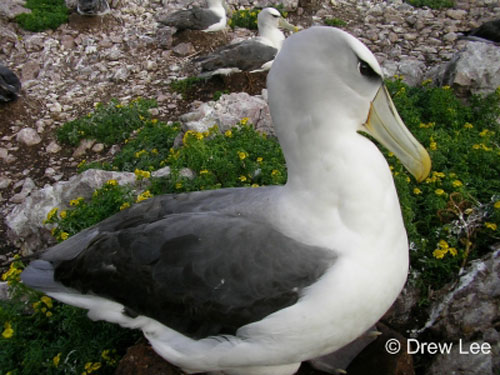Rachael Alderman has been awarded a PhD by the University of Tasmania for her research on population status and trends of the Shy Albatross Thalassarche cauta, endemic to the country.
The thesis abstract follows:
"Despite recent global conservation efforts, albatrosses remain amongst the most threatened groups of birds. Worldwide, they are affected on land and at sea by a range of processes, particularly fisheries bycatch. In spite of their high conservation profile, albatrosses present challenges for monitoring and recovery actions because they are long-lived, spend most of their life at sea and return to breed at colonies that are often located on remote, relatively inaccessible islands. This thesis offers a comprehensive assessment of the population status and trends of Australia's endemic shy albatross, Thalassarche cauta, which breeds exclusively on three Tasmanian offshore islands. The main anthropogenic, physical and environmental processes that influence each of the three breeding populations are examined and the processes that shape key demographic parameters and trends are assessed in four analytical chapters which follow the introductory chapter. Chapter two compiles and analyses available population and demographic data to provide the first comprehensive assessment of the status and trends of the three individual shy albatross colonies and of the species as a whole. This chapter shows that the Albatross Island population has recently stabilised following a period of sustained increase post-harvest and that this change in trajectory appears driven by a decrease in juvenile survival. The small Pedra Branca population is declining, likely due to reduced breeding success associated with the increasing population of Australasian gannets on the island. While trends for Mewstone, the largest breeding population, are unknown, it is shown that birds from this colony have greater exposure to commercial fisheries, are therefore at higher risk of fishing-related mortality and, consequently, survival rates for this population are likely lower than their Albatross Island counterparts. Collectively, these results suggest the current status of the shy albatross is likely to be stable at best and quite possibly decreasing. The third chapter uses satellite tracking data to investigate the at-sea distribution of post-fledging shy albatrosses. Data show colony-specific dispersal behaviour and subsequent post-fledging range. Accordingly, the three populations differ in the extent to which juveniles overlap with commercial fisheries and their consequent risk of by-catch. The satellite data and supporting evidence from band recoveries also show that juvenile mortality is highest in the period immediately after fledging, with population differences in the frequency of mortality also apparent. Post-fledging mortality is likely related to foraging failure of naive birds and the observed population differences may be related to proximity of colonies to food resources. Considering the combined impact of environmental and fisheries influences, it is probable that the juvenile survival rates for the two southern populations, and for Mewstone in particular, are lower than the northern, well-studied, Albatross Island population. In line with the increasing focus of managers and researchers on understanding climate impacts on threatened species, chapter four assesses the efficacy of existing long term monitoring on Albatross Island in detecting the influence of climate change on the breeding performance of this population. This study shows that the current sampling design is biased towards older, more experienced breeding individuals, which are better able to buffer the effects of climate variability and thereby obscure climate signals. Modifications to the monitoring protocols are suggested, including the deliberate sampling of younger birds to provide a more sensitive and effective ecological indicator of the effects of climate variability and climate change on this population. The fifth chapter takes the existing breeding-success time-series and investigates the relationship of this important life-history parameter with a range of local and regional environmental variables. The strongest relationships were found with environmental conditions during chick-rearing, including rainfall and maximum temperature during this period at the breeding site, and with sea-surface height anomalies associated with increased upwelling in the primary foraging areas during both incubation and the chick-rearing phases. The population implications of these climate-biology relationships given future predictions for climate change are considered. These findings are synthesised to produce the first comprehensive report of the overall conservation status of the shy albatross and a key conclusion of this research is that the species is not as secure as previously believed. In addition to contributing to our understanding of the status of the species, this thesis highlights a range of threatening processes and their underlying mechanisms and provides clear guidance for future management and monitoring of this species, findings that can be extended to other threatened seabird species."

Shy Albatross on Albatross Island, Bass Strait, Australia
Photograph by Drew Lee
References:
Alderman, R.L. 2012. The Shy Albatross (Thalassarche cauta): Population Trends, Environmental and Anthropogenic Drivers, and the Future for Management and Conservation. PhD thesis, University of Tasmania. 180 pp.
Alderman, R.L. & Gales, G. 2012. The Shy Albatross: status, survival and threats. In: Fifth International Albatross & Petrel Conference 12 - 17 August, 2012 Wellington, New Zealand Conference Programme and Abstracts. P1.
Rachael is based in the Marine Conservation Program, Biodiversity Monitoring Section, Biodiversity Conservation Branch, Department of Primary Industries, Parks, Water & Environment in Hobart, Tasmania.
John Cooper, ACAP Information Officer, 17 September 2012

 English
English  Français
Français  Español
Español